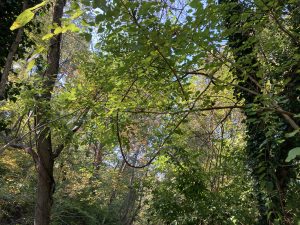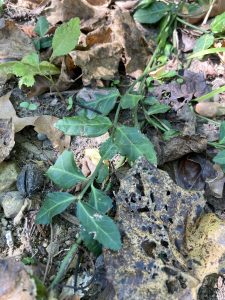Upon my immediate arrival to my sit-spot, I became aware of a cacophony of noises that had previously been masked by the pattering of rain. The melodies of indistinct insects muddled together to create a symphony while a cricket across the stream to the north delivered the occasional, yet powerful, solo performance. Lonesome birds to in the north and south-west sang their succinct melodies. Their songs flowing over one another to the point of relative ambiguity. Sounds that would seem to be discordant and inharmonious came together to create an experience like no other. And then there was silence. The music had come to an abrupt stop. Initially I believed my presence had perhaps frightened the organisms to still, but then I realized my ears had focused on another noise that had also been previously been masked by the rain. Far off, to the distant north, came a low rumbling that refused to cease. It was this heavy, monotonous droning of the distant highway that fought for supremacy and won against the delicate sounds of nature that laid before me. This dichotomy made me realize that I had to refocus my senses to ensure my attention did not wander.
I decided to instead focus my attention on the way light interacted with its surroundings. The first time I went to my sit-spot was an overcast and rainy day. While this type of scene is beautiful in its own regard, the way sunlight interacts with and transforms its environment is of particular interest to me. I observed how light cascaded through the canopy of leaves above; transforming pesky, little gnats into fantastical fairly-lights that twinkled against the bleak forest background. Or how the light played off of the stream below, glinting and glimmering as the stream slowly flowed by. And ultimately how the stream helped reflect its rays back up and onto the underside of leaves, leaves that would otherwise never experience the kiss of sunlight. It was after these observations that the sounds of nature slowly started coming back to me.
Since the stream was no longer lapping at my feet in an attempt to escape the confines of its bed, I decided to descend the bank for a closer examination. Tucked securely away in a small patch of sunlight by the eastern bank laid a slew of water-striders. I watched as they sleepily floated down the stream and marveled as they shot back towards their original location. I knew water-striders possessed the ability to float on water, yet I never truly acknowledged how they put this ability to use. As I watched them, I was struck with wonder as to why they would do this. Why did these insects insist on staying in this location? What was it about this area in particular that had drawn upwards of ten to fifteen water-striders? The answer I came up with as an explanation was how these water striders could potentially be safest in an area of slow-moving water since they would be able to sense the changes in vibrations as a predator approaches. Or perhaps it is because these water striders were preying on some type of larvae that my untrained eyes could not recognize. Regardless of reason, watching water-striders flit back and forth in a gentle eddy is enough to calm even the most hectic mind.
Watch a Water Strider Move Around!
As I walked back up the bank to my sit-spot, I considered how much of an impact the river had on the biotic factors of the surrounding environment. One of the most blatant differences in my scenery was the nature of the stream. A coursing, surging body of murky water in the rain had been reduced to a steady trickle of crystal-clear water. Some areas were deeper than others, but I doubted that the unpredictable rise and fall of the river would be sustainable for organisms such as fish or crawdads in this particular area of the stream. I considered the impact that the stream had on the plants in that general location. I thought back to our stomate lab and realized that the leaves in this area would most likely have a lower density of stomata considering their proximity to a body of water. I also considered how the water of the stream would cause falling leaves to decompose at faster rates, helping support the existence of macroinvertebrates and any other microorganisms hidden in the water.
As for the objects that I marked for further observation, I realized that there had already been changes to all three objects. I quickly came to realize that the branches of the tree did not in fact stretch across the stream. Instead, they stopped short of the eastern side of the riverbank, the side closest to my location. I noticed this because the leaves of the surrounding trees had either fallen off or changed into lovely autumnal colors. I would like to make it clear however that I do not wish to offend my tree by implying its green leaves are any less lovely, their stark contrast against the fall colors have simply marked where the extent of its branches lies. The spider’s web was the next object that had changed with this new perspective. The web, which I had previously described as a hammock-like structure suspended between two branches, turned out to be much more complex. The densest spindles of the web lie at the bottom, but above this are a multitude of strands that fill the space. The final object I set to observe was the vine-like plant that grew close to the ground. Perhaps it was the rain that invigorated the plant, but it was looking rather droopy when I last saw it. The color was much duller than before, bits and pieces of the foliage had browned, and there were small holes in some of the leaves. Perhaps this plant is not as hardy as I initially thought.
Overall, this experience truly caused me to recognize the variability of nature. I arrived at my sit-spot at relatively similar times of day but was met with two drastically different scenes. One welcomed me with open arms, allowing my shadows to meld with those of the dancing leaves as the sun played over our forms. The other permitted me to be a silent listener with sharp eyes directed toward the clouded environment before me. Both experiences held their own type of beauty. This time around I could practically feel the buzz of life surrounding me, yet the time before had a quiet serenity that allowed for careful observation. Either way, the sit-spot experience was a nice escape from the day-to-day tasks and subsequent worries.







love your cover photo!
You have lovely use of language – I was drawn in immediately – Great job!
I loved hearing about this water strider, I definitely never thought about why they actually stay on top of the water, much less how they do it!